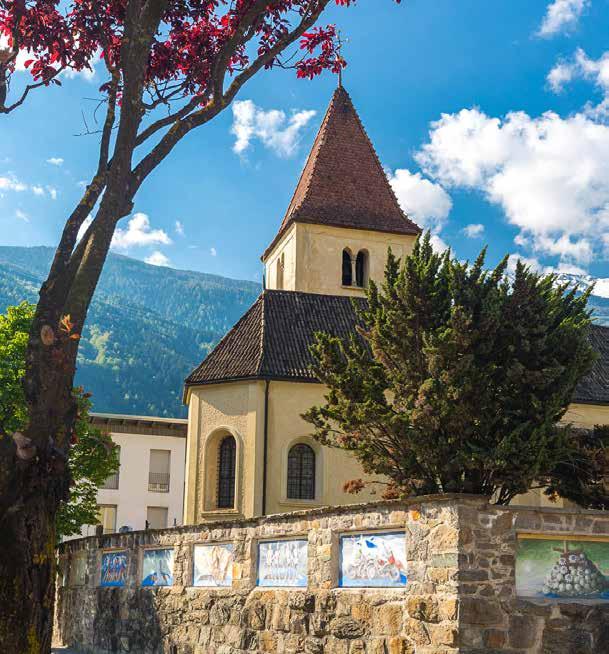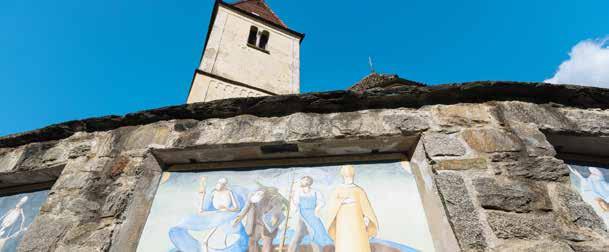
2 minute read
Miss Riesling Ms. Riesling
IL PENSIERO DI VISITARE LA DANZA MACABRA PUÒ SEMBRARE DI PRIMO ACCHITO DEPRIMENTE. NEL 2001 L’ARTISTA VENOSTANO LUIS STEFAN STECHER HA TERMINATO IL SUO LAVORO SUL MURO DI CINTA DEL CIMITERO PRESSO LA CHIESA DI SAN NICOLA, A PLAUS, DOVE UN TEMPO SI TROVAVA UNA ANTICA DANZA MACABRA.
In 18 pannelli colorati, per una lunghezza complessiva di 36 metri, Stecher mostra che la morte è la grande livellatrice: indipendentemente dall’età, dalla classe sociale o dallo status, ella invita tutti ad un ultimo ballo. Stecher usa spesso caratteri e personaggi tipici della Val Venosta: i famosi Kårrner, nomadi “autoctoni” che attraversano la valle con i loro carri, i contadini coi loro grembiuli blu o il motociclista in sella alla sua Harley-Davidson sul famigerato rettilineo di Plaus. Le impressionanti immagini sono completate da cartigli in dialetto venostano, che rimandano senza sosta e con ironia alla finitezza della vita. Cammino lungo il muro del cimitero, dietro di me un gruppo di bambini in bicicletta sfrecciano oltre, si sente il rumore delle tazze e il chiacchiericcio delle voci degli ospiti del bar. Poi succede qualcosa di strano: alla fine del tour la sensazione non è più deprimente, ma allegra. La vita è bella, godiamocela.
THE THOUGHT OF VISITING THE DANCE MACABRE IN PLAUS MAY AT FIRST SEEM GLOOMY. IN 2001 LOCAL ARTIST LUIS STEFAN STECHER FINISHED HIS DANCE MACABRE FRESCO ON THE OUTER CEMETERY WALL OF THE CHURCH OF ST. NICHOLAS IN PLAUS – IN PLACE OF THE ORIGINAL AND NO LONGER PRESERVED ONE.
Over 18 colorful panels, a total of 36 meters long, Stecher shows that death is the great equaliser: regardless of age, guild or status, it invites everyone to a final dance. Stecher often uses local traditional motifs: for example the famous “Kårrner”, regional nomads who travelled through the valley with their carts, or farmers in traditional blue aprons, or even motorcyclists on the infamous “Straight Road of Plaus”. The impressive pictures are complemented by banners written in local dialect, which relentlessly and ironically refer to the finiteness of life. I walk along the cemetery wall, while behind me a group of children whiz past on their bicycles. You can hear cups clattering and the babble of voices of the guests in the café. Then something strange happens: at the end of the tour the feeling is no longer depressing, but cheerful. Life is good, so let’s enjoy it to the full.

18
pannelli colorati, per una lunghezza complessiva di 36 metri, Stecher mostra che la morte é la grande livellatrice. colorful panels, a total of 36 meters long, Stecher shows that death is the great equaliser.










